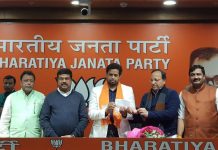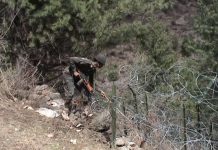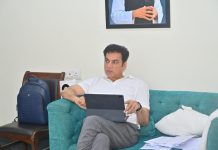The struggle in the sprawling forests of Chhattisgarh tells the bloody story of the state, the naxals and the people caught in the crossfire
Ajit Sahi, Editor-at-Large

Photo: Vijay Pandey
FIRST, A DISCLAIMER: I do not support, justify or approve of the Naxals’ creed of violence. I don’t even believe that they can secure for their peoples the lofty goals of liberty, justice and equity by the means of violence. As Mahatma Gandhi powerfully argued through his public actions and in his copious writings on human history, no one — not even a State — can sustain a moral order using the immoral means of violence. Indeed, Gandhi’s refusal to seek from the British a pardon for Bhagat Singh, Rajguru and Sukhdeo brought him ridicule at the time, and is still unforgiven by millions of followers of the Shaheed-e-Azam. But Gandhi — pardon the expression — stuck to his guns in opposing the creed of violence, irrespective of the practitioner.
On March 23, 1931, after the British hanged the trio, Gandhi wrote: “These heroes had conquered the fear of death. Let us bow to them a thousand times for their heroism. But we should not imitate their act. In our land of millions of destitute and crippled people, if we take to the practice of seeking justice through murder, there will be a terrifying situation. Our poor people will become victims of our atrocities. By making a dharma of violence, we shall be reaping the fruit of our own actions.” Gandhi could well be speaking for the millions of Chhattisgarh’s tribals, who today face a terrible fate as both the Naxals and the State have adopted the dharma of violence and arguably stare at the worst face-off in the Naxals’ 40-year insurgency. It would be futile to indulge in crystal ball gazing on the likely outcome of Operation Green Hunt, the all-out paramilitary offensive against the Naxals that’s already dug in heels in south Chhattisgarh and is expected to turn full-blown in November. Watchers fear that the State will end up killing far more non-Naxal innocent tribal people than the Naxals, who have been entrenched in the deep forests for over four decades.
But this is not about condemning the Naxals’ or the State’s violence. This is about asking hard questions about why the Naxal violence exists. Again, Gandhi’s writing on the day of Bhagat Singh’s martyrdom could well describe both the Naxal and her supporters among the tribal populations. Wrote Gandhi: “Bhagat Singh was not a devotee of non-violence, but he did not subscribe to the religion of violence. He took to violence due to helplessness and to defend his homeland”(italics mine).
Gandhi could be speaking of the “helplessness” of thousands of Chhattisgarh tribals who’ve been driven into the arms of the Naxals due to the terrorist violence let loose since 2005 by the controversial police-backed tribal militia Salwa Judum (literally: Peace March), who have killed, maimed, burnt, hacked, raped the tribals and continue to do so.
This is news that you are never likely to hear from PM Manmohan Singh or Home Minister P Chidambaram, who only tell you that the Naxals are the biggest terrorist threat to India. They and their echo chambers in the media resonate with a singular narrative, crassly distilled by our learned home minister as “you-are-either-with-‘us’-orwith- the-Naxals”. Anyone who so much as questions the justness or even the efficacy of Operation Green Hunt is decried as a double-faced ‘Leftist intellectual’ who must be condemned for supporting the insane violence of “India’s worst enemies”. This narrative goes like this: the Naxals are gun-toting, crazed ideologues who reject the State and have vowed to replace it with a non-democratic Maoist-Communist State. (“I would not like to live in a Naxal State,” said filmmaker Sudhir Mishra — who’s made a movie on the Naxal quagmire — on a CNN-IBN show last week. Ergo, he seemed to suggest, the take-no-prisoners Operation Green Hunt is justified.)
Anyone who so much as questions the justness or even the efficacy of Operation Green Hunt is decried as a double-faced‘Leftist intellectual’
The narrative further says that these terrorist Naxals are hardened beasts that kill our policemen with utter brutality, ambushing them, beheading them. Who in their right minds could ever even appear soft on such hateful beings?
After 9/11, when US President George Bush facetiously argued that the terrorists attacked his country because “they hate our freedoms”, veteran British reporter of the Middle East war theatre, Robert Fisk — the world’s only journalist to have interviewed Osama bin Laden thrice — said that if the inquiry into a robbery must begin with the motive, the question to ask is: why did the 9/11 perpetrators carry out these heinous acts? Similarly, India deserves to know: what is the Naxals’ motive in relentlessly killing the police and security agencies like beasts? Here’s why.
The villagers who had found an answer in Gandhian methods of resistance are now being pushed towards the Naxals due to State oppression
On October 12, 2009, police swarmed the district collector’s office in Jagdalpur, a small town in south Chhattisgarh. They were there to prevent thousands of villagers from storming a jan sunwai (public hearing) called to debate the Environmental Impact Assessment (EIA) report for a proposed Tata steel plant in the district. Legally, this meeting should have been open to all, especially to the 6,000-odd people of the 10 villages near Jagdalpur that the steel plant will gobble up.
THERE IS strong resistance in at least six of these 10 villages to be displaced from their lands for the project. Most people have refused to accept compensation for land. Four of these six villages (Kumbli, Dhuragaon, Takaraguda and Sirisguda) passed resolutions in gram sabhas during October 2-6 asking the district administration to postpone the public hearing due to the climate of uncertainty created by Operation Green Hunt. About 1,000 letters on these resolutions were sent to the district collector.

Photo: Himanshu Kumar
Of course, the district collector didn’t postpone the hearing. Instead, the police set up barricades along the 30-km stretch from the villages to Jagdalpur, and stopped all buses so that villagers who might protest the Tatas’ project don’t reach the public hearing. About 25 villagers, led by former CPI MLA Manish Kunjam, did reach the public hearing. “We asked them, where would the effluence from the steel plant be dumped?” Kunjam told me over the phone. “They had no answer.” Kunjam says the Tatas’ EIA report (prepared by Dastur & Co) has failed to meet the standards set by two crucial policies that govern the displacement of tribals for industrial projects: the National Rehabilitation Policy and the Panchayat Extension to the Scheduled Areas Act.
According to both, the EIA report for an industrial project that would displace tribal people must also look into the “social impact” besides the environmental impact. “There is no mention of the ‘social impact’ in the report,” says Kunjam. The Indian Constitution, through Schedules 5 and 6, gives special status to the tribal people. Further, by signing a UN treaty in 1957, India had promised that displaced tribals would be given good land in lieu of that acquired.
Of course, this guarantee didn’t work for the poor tribals of the Narmada Valley earlier this decade, as the Supreme Court allowed dams on the river which displaced millions of villagers, on the grounds that such action met “overriding national interest”. But such an argument could hardly be pressed in the courts in favour of a steel plant. No wonder then that the Centre and the Chhattisgarh government are restive as the Tatas’ project is delayed because of the villagers’ refusal to part with land.
Technically, the Tatas have completed the ‘land acquisition process’. Some villagers have initiated a Chhattisgarh High Court lawsuit arguing against the Tata project, but few have faith in the outcome of the judicial process, knowing how slowly that wheel always turns. It must be said that the steel plant has support in and around Jagdalpur town, perhaps due to the belief that it will bring jobs. Two months ago, the Naxals killed a local politician, Vimal Meshram, who had vociferously supported the steel project. Activists working in Bastar for long say the Naxals had little presence in Lohandiguda, where the 10 villages are located, until the Tatas’ project controversy warmed up. Today, unsurprisingly, the Naxals are said to have struck roots in the region.
ON THE day — October 12 — the government turned the public hearing on the Tata EIA into a farce, long-time Bastar resident and Gandhian activist Himanshu Kumar had visitors late at night at his makeshift ashram in the smaller town of Dantewada, west of Jagdalpur. These were survivors of attacks by the police and Special Police Officers (SPOs) drawn from the Salwa Judum.
While the media highlighted the Naxals’ beheading of policemen, allegations that the police and Salwa Judum-SPOS have been killing tribals and creating terror in Bastar forests have been consigned to the media’s black hole. Sitting through the night to take their testimonies, Kumar prepared a list of people who have been killed in two attacks in the last three weeks, on September 17-18 and then on October 1. Here are just some of them:
• SPOs killed Madvi Deva of village Gachhanpalli at a rivulet on September 17. Another village’s Patel claimed seeing Deva being buried in the Chintagupha police station compound.
• CRPF men and SPOs cut off the breasts of 70-year-old Dudhi Muye, an invalid who could not walk, and stabbed her to death on September 17.
• CRPF and SPOs caught Madkami Muke of village Gachhanpalli and tied her up with her own sari. They beat, stabbed and shot her husband in front of her. Muke saw the attackers stab and shoot Madvi Joga, 60, in his field. She saw them strip 35-year-old Madvi Hidma, stab and shoot her.
• Also in Gompad village, four of a family — Madvi Bajar, 45, his wife Madvi Subbi, his married daughter, Kartam Kanni, 20, and younger daughter Madvi Mutti, 15 — were killed by SPOs. The attackers cut off the tongue and fingers of Kartam Kanni’s two-year-old son.
• Muchaki Aanda of Bhandarpadar village and his nephew, Madvi Deva, were returning from Andhra Pradesh when the police caught them. They were hacked to death with axes and knives, their bodies dumped near corn fields. Two villagers informed Deva’s mother, Madvi Joge, of their killing.
On October 11, Kumar and several other activists and lawyers travelled south of Dantewada to visit Nendra village. Until last year, Nendra had been a ghost town, after the Salwa Judum burnt it down two years ago, forcing residents to flee. Kumar’s NGO, Vanvasi Chetna Ashram (VCA), had had it rebuilt and persuaded the villagers to return. Within hours of the activists’ visit to the village, news of their presence spread quickly. More than 200 people from villages nearby assembled there, converting the meeting into a people’s tribunal. Since September the SPOs have killed wantonly in Nendra. Six people have gone missing.
In the last two months, as a precursor to Operation Green Hunt, police have harassed VCA activists. One volunteer has been jailed and tortured on false charges. Ironically, the Naxals, too, distrust Kumar, especially because of his efforts to repopulate the villages burnt down by Salwa Judum. You see, the people of those villages have found an answer away from both the Naxals and the Indian State, in Kumar’s Gandhian methods of resistance. Many of those who have gone back to their villages had been eager to turn the Naxals away.
But now, of course, the renewed Salwa Judum violence and Operation Green Hunt could once again quickly fatten the Naxals’ enrollment registers. Such is the scale of the Indian State’s violence that it is turning even Kumar increasingly despondent. “I stare dumbly at all these people who come to me, the old man who saw his daughter raped and son shot dead, the young wife who was raped repeatedly, the family whose house was burnt down,” Kumar said to me one night on the phone from Dantewada, unable to sleep. “They keep saying to me: help us. I keep quiet. Because how do I help them?”
And then, he added: “I am too much a son of Mahatma Gandhi and Vinoba Bhave to ever leave the path of nonviolence. But I look at these people and wonder, if I were a tribal person, raped, shot, abused, humiliated, wouldn’t I, too, pick up the gun to defend my family, my home, my lands, my forests?”
WRITER’S EMAIL
ajit@tehelka.com













